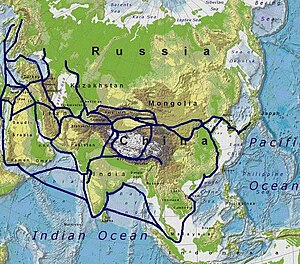
Back تاريخ آسيا Arabic Historia d'Asia AST Азия тарихы Bashkir Gschicht vo Asien BAR История на Азия Bulgarian এশিয়ার ইতিহাস Bengali/Bangla Història d'Àsia Catalan Dějiny Asie Czech Hanes Asia Welsh Geschichte Asiens German



The history of Asia can be seen as the history of several distinct regions, East Asia, South Asia, and the Middle East that have more or less context depending of the situation in the central Eurasian steppe.
The coastal periphery was the home to some of the world's earliest known civilizations, with each of the three regions developing early civilizations around fertile river valleys. The civilizations in Mesopotamia, the Indus Valley, and China had much in common. Therefore, it is likely that they exchanged technologies and ideas such as mathematics and the wheel. Other aspects such as that of writing developed individually in each area. Cities, states and then empires developed in these lowlands.
The steppe region had long been inhabited by nomads, and from the central steppes they could reach all areas of the Asian continent. The earliest known expansion out of the steppe is that of the Indo-Europeans which spread their languages into the Middle East, the Indian subcontinent, and in the Tocharians to the borders of today's China. The northern part of the continent was not accessible to the steppe nomads due to the dense forests and the tundra. These areas had very few people.
The centre and periphery were kept separate by mountains and deserts. The Caucasus, Himalaya, Karakum Desert, and Gobi Desert formed barriers that the steppe horsemen could only cross with difficulty. The city dwellers were more advanced in civilisation but they could do little militarily to defend against the mounted hordes of the steppe. Because the lowlands did not have enough open grasslands to support a large horsebound force the nomads who conquered states in China, India, and the Middle East were soon forced to adapt to the local societies.